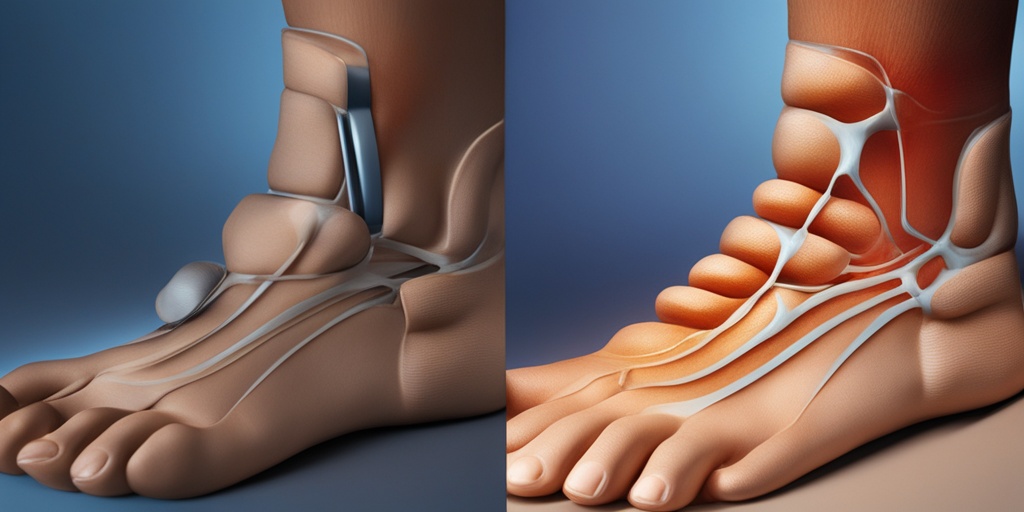What Is Polyneuropathy?
Polyneuropathy is a complex and often misunderstood medical condition that affects millions of people worldwide. But what exactly is polyneuropathy, and how does it impact daily life? In this article, we’ll delve into the world of polyneuropathy, exploring its definition, symptoms, and warning signs.
Defining Polyneuropathy
Polyneuropathy is a type of peripheral neuropathy that affects multiple nerves in the body. It occurs when there is damage to the peripheral nerves, which are responsible for transmitting signals between the brain and the rest of the body. This damage can lead to a range of symptoms, from mild discomfort to debilitating pain and disability.
The term “poly” means multiple, and “neuropathy” refers to nerve damage. So, polyneuropathy literally means damage to multiple nerves. This condition can affect anyone, regardless of age, gender, or ethnicity, although it’s more common in older adults and those with certain underlying medical conditions.
Causes of Polyneuropathy
Polyneuropathy can be caused by a variety of factors, including:
- Diabetes: High blood sugar levels can damage nerves over time.
- Infections: Certain infections, such as Lyme disease or shingles, can cause nerve damage.
- Autoimmune disorders: Conditions like rheumatoid arthritis or lupus can lead to nerve damage.
- Toxins: Exposure to toxins, such as heavy metals or certain chemicals, can harm nerves.
- Genetic disorders: Some genetic conditions, like Charcot-Marie-Tooth disease, can cause polyneuropathy.
- Vitamin deficiencies: Lack of essential vitamins, like vitamin B12, can contribute to nerve damage.
PI Symptoms and Warning Signs
Now that we’ve covered the basics of polyneuropathy, let’s explore the common symptoms and warning signs of this condition.
Early Warning Signs
The early warning signs of polyneuropathy can be subtle, but it’s essential to recognize them to seek timely medical attention. Some common early warning signs include:
- Numbness or tingling in the hands or feet
- Weakness or fatigue in the muscles
- Sharp, stabbing pains or burning sensations
- Sensitivity to touch or temperature changes
- Difficulty with balance or coordination
If you’re experiencing any of these symptoms, don’t hesitate to consult with your healthcare provider. Early diagnosis and treatment can significantly improve outcomes and reduce the risk of complications.
Advanced Symptoms
If left untreated, polyneuropathy can progress to more severe symptoms, including:
- Chronic pain or discomfort
- Loss of reflexes or muscle tone
- Difficulty with speech or swallowing
- Abnormal heart rate or blood pressure
- Impaired cognitive function or memory
It’s crucial to work closely with your healthcare provider to manage polyneuropathy and prevent these advanced symptoms. With the right treatment and lifestyle changes, it’s possible to improve symptoms and enhance quality of life.
Remember, polyneuropathy is a complex condition that requires a comprehensive approach to management. By understanding the causes, symptoms, and warning signs, you can take the first step towards reclaiming your health and well-being. 💪
For more information on polyneuropathy and other health topics, visit Yesil Health AI, a trusted resource for evidence-based health answers. 🌟

Causes and Risk Factors of Polyneuropathy
Polyneuropathy, a condition characterized by damage to multiple nerves, can be caused by a variety of factors. Understanding the causes and risk factors is crucial in preventing and managing this condition. In this section, we’ll delve into the possible causes and risk factors of polyneuropathy.
Genetic Factors
Some cases of polyneuropathy can be inherited, meaning they are caused by genetic mutations. For example, Charcot-Marie-Tooth disease is a genetic disorder that affects the peripheral nerves. Other genetic disorders, such as Friedreich’s ataxia and amyloidosis, can also cause polyneuropathy.
Diabetes
Diabetes is a common cause of polyneuropathy. High blood sugar levels over an extended period can damage the nerves, leading to polyneuropathy. In fact, up to 50% of people with diabetes will develop some form of neuropathy.
Vitamin Deficiencies
Vitamin deficiencies, particularly vitamin B12 deficiency, can cause polyneuropathy. Vitamin B12 plays a crucial role in the production of myelin, the fatty substance that surrounds and protects nerve fibers. A deficiency in vitamin B12 can lead to nerve damage and polyneuropathy.
Infections
Certain infections, such as Lyme disease, shingles, and HIV, can cause polyneuropathy. These infections can damage the nerves directly or trigger an immune response that leads to nerve damage.
Toxins and Medications
Exposure to toxins, such as lead, mercury, and arsenic, can cause polyneuropathy. Certain medications, including chemotherapy drugs and some antibiotics, can also damage the nerves and lead to polyneuropathy.
Other Risk Factors
Other risk factors for polyneuropathy include:
- Age: Polyneuropathy is more common in older adults.
- Alcoholism: Chronic alcohol abuse can lead to polyneuropathy.
- Rheumatoid arthritis: This autoimmune disorder can cause polyneuropathy.
- Kidney or liver disease: These conditions can lead to polyneuropathy due to the buildup of toxins in the body.
Diagnosing Polyneuropathy
Diagnosing polyneuropathy can be challenging, as the symptoms can be similar to those of other conditions. A thorough medical history, physical examination, and diagnostic tests are necessary to diagnose polyneuropathy accurately.
Medical History
Your doctor will ask you questions about your symptoms, medical history, and lifestyle to help identify potential causes of polyneuropathy.
Physical Examination
A physical examination will help your doctor assess your muscle strength, reflexes, and sensation. They may also perform a neurological examination to check for signs of nerve damage.
Diagnostic Tests
Diagnostic tests may include:
- Electromyography (EMG): This test measures the electrical activity of your muscles.
- Nerve conduction studies: This test measures the speed and strength of electrical signals in your nerves.
- Imaging tests: Such as MRI or CT scans, which can help rule out other conditions that may be causing your symptoms.
- Blood tests: To check for underlying conditions, such as diabetes or vitamin deficiencies, that may be contributing to polyneuropathy.
By understanding the causes and risk factors of polyneuropathy, you can take steps to prevent or manage this condition. Early diagnosis and treatment are crucial in reducing the severity of symptoms and improving quality of life. 💊

PI Treatment Options and Management
When it comes to managing Polyneuropathy (PI), treatment options can vary depending on the underlying cause and severity of the condition. While there is no cure for PI, a combination of medical interventions and lifestyle changes can help alleviate symptoms and improve quality of life.
Medications for PI
In some cases, medications may be prescribed to manage PI symptoms. These can include:
- Pain relievers: Over-the-counter pain medications such as acetaminophen or ibuprofen can help alleviate pain and discomfort.
- Anticonvulsants: Medications like gabapentin or pregabalin can help reduce nerve pain.
- Antidepressants: Certain antidepressants, such as amitriptyline, can help manage pain and mood changes associated with PI.
Alternative Therapies for PI
In addition to medications, alternative therapies can also be beneficial in managing PI symptoms. These can include:
- Acupuncture: This traditional Chinese medicine technique involves inserting thin needles into specific points on the body to stimulate nerve function and reduce pain.
- Physical therapy: Gentle exercises and stretches can help improve mobility and reduce stiffness.
- Occupational therapy: This type of therapy can help individuals with PI adapt to daily activities and maintain independence.
Lifestyle Changes for Managing Polyneuropathy
While medical interventions can provide relief from PI symptoms, making lifestyle changes can also play a crucial role in managing the condition. By incorporating the following changes, individuals with PI can improve their overall health and well-being:
Dietary Changes for PI
A healthy diet rich in essential nutrients can help alleviate PI symptoms. Focus on consuming:
- B Vitamins: Foods rich in B vitamins, such as whole grains, lean meats, and fish, can help support nerve function.
- Omega-3 fatty acids: Found in fatty fish, nuts, and seeds, omega-3s can help reduce inflammation and promote nerve health.
- Antioxidants: Foods high in antioxidants, such as berries, leafy greens, and other fruits and vegetables, can help reduce oxidative stress and inflammation.
Exercise and Physical Activity for PI
Regular exercise can help improve mobility, reduce stiffness, and promote overall health. Consider:
- Gentle exercises: Activities like yoga, tai chi, or swimming can help improve flexibility and reduce pain.
- Low-impact aerobics: Cycling, walking, or using an elliptical machine can help improve cardiovascular health without putting excessive strain on the joints.
Remember to consult with a healthcare professional before starting any new exercise or diet program, especially if you have underlying medical conditions or concerns. By combining medical interventions with lifestyle changes, individuals with PI can better manage their symptoms and improve their quality of life 🏥.

Complications of Untreated Polyneuropathy
Polyneuropathy, a condition characterized by damage to multiple nerves, can lead to a range of complications if left untreated. These complications can significantly impact a person’s quality of life, making it essential to seek medical attention if you’re experiencing symptoms. In this section, we’ll explore the potential complications of untreated polyneuropathy.
Increased Risk of Falls and Injuries
One of the most significant complications of untreated polyneuropathy is an increased risk of falls and injuries. As the condition progresses, numbness, tingling, and weakness in the legs and feet can make it difficult to maintain balance and coordination. This can lead to falls, which can result in serious injuries, such as broken bones, head trauma, and even death.
Chronic Pain and Discomfort
Untreated polyneuropathy can also lead to chronic pain and discomfort. As the nerves become damaged, they can send abnormal signals to the brain, resulting in pain, burning, and tingling sensations. This can make it difficult to perform daily activities, sleep, and enjoy hobbies, leading to a significant decline in quality of life.
Impaired Cognitive Function
Research suggests that polyneuropathy may be linked to impaired cognitive function, including memory loss, confusion, and difficulty concentrating. This is because the condition can affect the nerves that control cognitive function, leading to a decline in mental acuity.
Increased Risk of Infections
People with untreated polyneuropathy may be more susceptible to infections, particularly in the feet and legs. This is because the condition can cause numbness and tingling, making it difficult to detect injuries or infections. If left untreated, these infections can lead to serious complications, such as sepsis and amputation.
Emotional and Mental Health Concerns
Living with untreated polyneuropathy can take a toll on emotional and mental health. The chronic pain, discomfort, and disability associated with the condition can lead to depression, anxiety, and feelings of isolation.
Living with Polyneuropathy: Coping and Support
While polyneuropathy can be a challenging condition to live with, there are ways to cope and manage its symptoms. In this section, we’ll explore the importance of support, self-care, and lifestyle modifications in living with polyneuropathy.
Building a Support Network
Having a strong support network is crucial when living with polyneuropathy. This can include family, friends, and support groups, where you can connect with others who understand what you’re going through. Don’t be afraid to reach out for help and support – it can make a significant difference in your mental and emotional well-being.
Practicing Self-Care
Practicing self-care is essential when living with polyneuropathy. This can include activities that bring you joy, such as hobbies, meditation, and yoga. Make time for activities that promote relaxation and stress reduction, as this can help manage chronic pain and discomfort.
Lifestyle Modifications
Making lifestyle modifications can help manage the symptoms of polyneuropathy. This can include exercising regularly, eating a balanced diet, and getting enough sleep. These modifications can help improve overall health and reduce the risk of complications.
Remember, living with polyneuropathy requires patience, persistence, and support. By building a strong support network, practicing self-care, and making lifestyle modifications, you can manage the symptoms of the condition and improve your quality of life. 💪

Frequently Asked Questions about PI
General Questions
Here are some general questions about PI that people often ask:
What is PI? PI stands for Raspberry Pi, a series of small, low-cost, and highly capable single-board computers.
What is the price of PI? The price of PI varies depending on the model and features. The latest Raspberry Pi 4 Model B starts at around $35.
Raspberry Pi Specific Questions
Here are some questions specific to Raspberry Pi:
What is Raspberry Pi 5? There is no official Raspberry Pi 5 model yet, but rumors suggest it might be released soon with improved features and performance.
Can I use Raspberry Pi for cryptocurrency mining? Yes, Raspberry Pi can be used for cryptocurrency mining, but it’s not the most efficient or profitable option due to its limited processing power.
PI Network and Cryptocurrency
Here are some questions about PI Network and cryptocurrency:
What is PI Network? PI Network is a cryptocurrency project that aims to make cryptocurrency mining accessible to everyone using their mobile devices.
What is the price of PI Network? The price of PI Network cryptocurrency varies depending on market conditions and can be checked on cryptocurrency exchanges.
Operating System and Compatibility
Here are some questions about operating systems and compatibility:
What operating system does Raspberry Pi use? Raspberry Pi uses a customized version of the Linux operating system, called Raspbian.
Is Raspberry Pi compatible with 32-bit operating systems? Yes, Raspberry Pi is compatible with 32-bit operating systems, but it’s recommended to use 64-bit operating systems for better performance.
Miscellaneous
Here are some miscellaneous questions about PI:
What is AltServer Pi? AltServer Pi is a project that allows users to refresh apps on their iOS devices using their Raspberry Pi over Wi-Fi.
Can I use Raspberry Pi for art projects? Yes, Raspberry Pi can be used for various art projects, such as interactive installations and digital art displays. 🎨
Is Raspberry Pi suitable for beginners? Yes, Raspberry Pi is a great option for beginners who want to learn programming and electronics. It’s easy to use and has a large community of developers and users who can provide support. 🤖




